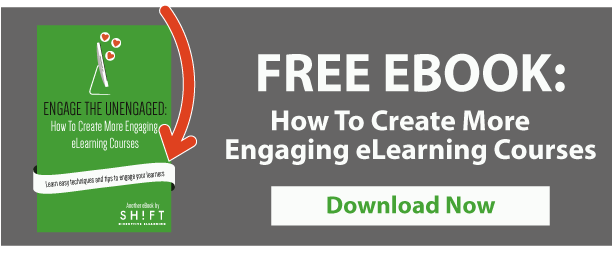Stories have captivated us as a species since the dawn of man. Through stories, we have passed on traditions, remembered the past, and carried information across the millennia.
And it's not just our ancestors who harnessed the power of stories, either. Stories still work to reach people, which is why we see businesses turning to the power of storytelling in branding efforts, marketing campaigns, corporate strategies, and even eLearning courses and business presentations.
The Power of Stories
Stories hold this power over our minds and hearts for a reason. They are how we think, how we make sense of information, how we define ourselves, and how we persuade others. According to a recent article in Psychology Today, stories continue to hold power in this digital age because the human brain hasn't evolved as fast as technology and it's only through stories that we can connect to the various digital platforms and media messages out there today.
In short, we still need stories to make sense of the world and our place in it.
Infusing stories into eLearning courses will increase the power of content and help the learner retain information better than other formats. One reason is the way the brain responds to stories. This 5-minute video scientifically explains why our brain loves stories. It shows us how stories can move us to tears, change our attitudes, opinions and behaviors, and even inspire us—and how stories change our brains, often for the better.
When you hear a story, your brain responds as if it were experiencing the events in the story. So if it's a sad or happy story, the corresponding regions of the brain will light up and engage. You actually use more of your brain when you listen to stories.
Secondly, research has shown that stories help us retain facts better, too. When people heard facts in a story form, 63 percent could recall the facts versus 5 percent of the audience in a traditional presentation.
Bringing Storytelling into eLearning
Since storytelling has such power to engage learners and help them retain information, it makes sense for eLearning to incorporate stories into learning designs.Not all stories are equal, though, so here are six key fundamentals for infusing your eLearning courses with stories. These tips will help you bring out your inner storyteller.
First, brush up on the storytelling essentials: The Periodic Table of Storytelling

#1. Know your audience.
The great American author John Steinbeck said it best in his epic novel East of Eden. "If a story is not about the hearer, he will not listen." Applied to eLearning, the stories you tell have to connect with your intended audience.
Develop the persona of your learner and really get to know that person. Answer questions like where will the learner engage with the content? What context will they most relate to? What language feels familiar to them? Then, craft your narratives to resonate with the learner.
This article will guide you through the essential steps to create personas.
#2. Use a structure.
Nothing is worse than a disorganized story. A solid, logical structure is part of what makes stories stick in our brains. All stories share a few common elements. They include:
- A beginning or hook;
- Rising action where the central conflict emerges;
- A climax, or the peak of action;
- And resolution, where the loose ends of the story are tied up.

Giving a structure to the story will add to the power of it as a learning design. Need some inspiration? Here are other 11 Story Structures for Storytelling.
#3. Appeal to emotions.
As we saw earlier, when we read stories, we experience the emotions of the stories as well. Emotional stories also make them more relevant to the learner. If you don't engage emotionally with a story, then why should you even care about it? It won't stick. Story elements like character, conflict and action help stories appeal to emotions. Without these elements, stories aren’t interesting or "sticky" enough. Make use of conflict, challenge, tension, and the corresponding resolution to help your learners resonate with your stories.
The book, The Seven Basic Plots: Why We Tell Stories, defines seven story types that have proven successful over the ages. This article does a good job summarizing them and includes great video examples. Use all the examples as inspiration to effectively apply storytelling in eLearning.
Additionally, here are some writing tips to make learners feel emotion too.
#4. Intensify the story with visuals.
Stories don't have to be, and really shouldn't be, text only. As we have written about before, too much text can overload a learner. Visuals break up the text and provide another avenue for learners to engage with the content.
For storytelling, visuals can reinforce key concepts, help learners make emotional connections, and keep learners engaged. Try adding illustrations, photographs, videos, or animation throughout the elearning course to back up the learning objectives of the story.
As an eLearning professional, knowing how to include emotionally charged images is fundamental. After all, using stories in your eLearning courses is all about creating a closer connection to your audience, and powerful visuals, whether they’re still images or video, cause a faster and stronger reaction than words.
According to Getty Images, the four key factors for powerful visuals are:
- Use authentic visuals
- Be culturally relevant to your audience
- Use visuals that reflect the human experience
- Use visual storytelling tools like archetypal characters
#5. Make the stories relevant to the course.
Simply adding any story to an eLearning course won't be effective. The story must related to the learning objectives of the course in order for it to have the effect you want.
Do not use stories simply to entertain or tell a history of something. Instead, use them to deliver a key lesson, much like Aesop did with his fables. They can be short, cover one learning objective, or tie a few together. But stories without a point will fall flat and leave your learner wondering.
#6. Pay attention to detail.
Strong, vivid details make stories come alive for the reader. Details help readers connect to the story and give the story credibility. When crafting stories for eLearning, your goal should be to help the learner create mental images of the narrative. Again, this activates the brain and deepens the impact of the learning.
Check out this article to have an idea of how you can make your stories "pop" with detailed imagery.
Despite the many technologies we now have at our fingertips, it's still the story that moves us as a species. By tapping into the amazing power of storytelling, you can design more powerful and effective elearning courses.
More helpful resources:
- 10 Steps to Create a Digital Story for Learning
- Boring to Brilliant: 5 Tips to Convert Your E-Learning to a Story-based Approach
- The Ultimate Guide to Storytelling
- Speaking Your Mind: Using elements of narrative storytelling in eLearning
- Slideshow: How to Use Stroytelling in eLearning?
- Storytelling Skills and Technique









